ASTM E1952 Thermal Conductivity Testing of Materials
The ASTM E1952 standard is a critical tool in the additive manufacturing and 3D printing sectors, enabling accurate measurement of thermal conductivity for materials used in these advanced manufacturing processes. This test method allows for the precise determination of how well a material conducts heat, which is essential for optimizing performance, ensuring safety, and achieving desired properties in complex geometries created by additive manufacturing.
Thermal conductivity testing using ASTM E1952 provides insights into how materials will behave under various thermal conditions. This knowledge is vital for quality managers and R&D engineers to understand the suitability of materials for specific applications. For instance, a material with high thermal conductivity may be preferred in cooling systems or heat exchangers, while low thermal conductivity might be desired in insulating components.
The test involves measuring the amount of heat that flows through a specimen over time under controlled conditions. Specimen preparation is crucial; it requires uniformity and homogeneity to ensure accurate results. The ASTM E1952 standard provides detailed guidelines on how to prepare specimens, including dimensions, surface finish, and orientation relative to the direction of heat flow.
Instrumentation used in this testing typically includes high-precision thermal conductivity meters capable of measuring minute temperature differences across a sample. These instruments must be calibrated regularly to ensure accuracy and reliability. The test setup often involves placing the specimen between two heated plates where one plate is maintained at a higher temperature than the other.
The results from ASTM E1952 testing are reported in terms of thermal conductivity values, which can vary significantly depending on the material type and its microstructure. This information helps quality managers and compliance officers ensure that materials meet specified performance criteria. R&D engineers rely on these data to refine their designs and improve product functionality.
Understanding the thermal properties of materials is not just beneficial for additive manufacturing but also extends to other sectors like aerospace, automotive, electronics, and construction. In each sector, accurate thermal conductivity measurements contribute to more efficient energy management systems and safer operations.
| Industry | Potential Impact on Performance | Quality Assurance |
|---|---|---|
| Aerospace | Optimizing heat exchanger design for weight reduction and improved fuel efficiency. | Ensuring materials do not degrade under extreme temperatures during flight. |
| Automotive | Developing better insulation systems to enhance vehicle energy efficiency. | Verifying that materials maintain their integrity in high-temperature environments such as engine compartments. |
| Electronics | Creating more efficient cooling solutions for electronic devices reducing overheating risks. | Guaranteeing the reliability of components operating within tight temperature tolerances. |
| Construction | Better thermal insulation leading to sustainable buildings with lower heating and cooling costs. | Avoiding condensation issues in building envelopes due to improper material selection. |
Industry Applications
- Metallic alloys used in additive manufacturing for aerospace components.
- Polymer-based composites employed in automotive applications requiring lightweight yet strong materials.
- Bio-degradable plastics suitable for 3D printing in medical device manufacturing.
- Silicon carbide ceramics utilized in high-temperature electronics and industrial equipment.
ASTM E1952 testing is particularly useful when evaluating the thermal performance of these advanced materials. The test results help ensure that the final products perform as expected under various operational conditions, thereby enhancing overall product quality and reliability.
Quality and Reliability Assurance
The ASTM E1952 standard plays a pivotal role in maintaining consistent material performance across additive manufacturing processes. By ensuring accurate thermal conductivity measurements, this test method helps manufacturers identify potential issues early in the production cycle. This proactive approach not only improves product quality but also reduces costly rework and recalls.
Quality managers use ASTM E1952 data to set strict acceptance criteria for incoming materials. Compliance officers rely on these results to ensure that all components meet regulatory requirements. R&D engineers benefit from this information when optimizing material properties to better suit specific applications.
A well-executed ASTM E1952 test ensures that the thermal performance of a material is consistent across multiple production runs. This consistency translates into more reliable and dependable products, which is especially important in sectors like aerospace and automotive where safety is paramount.
International Acceptance and Recognition
- The ASTM E1952 standard is widely recognized by industry leaders across the globe.
- It is adopted by many countries as part of their national standards for additive manufacturing.
- A number of international organizations, including ISO and IEC, reference ASTM E1952 in their own standards.
The global acceptance of ASTM E1952 underscores its importance in the field of thermal conductivity testing. This widespread adoption ensures that manufacturers can rely on consistent and accurate results regardless of location or local regulations.





